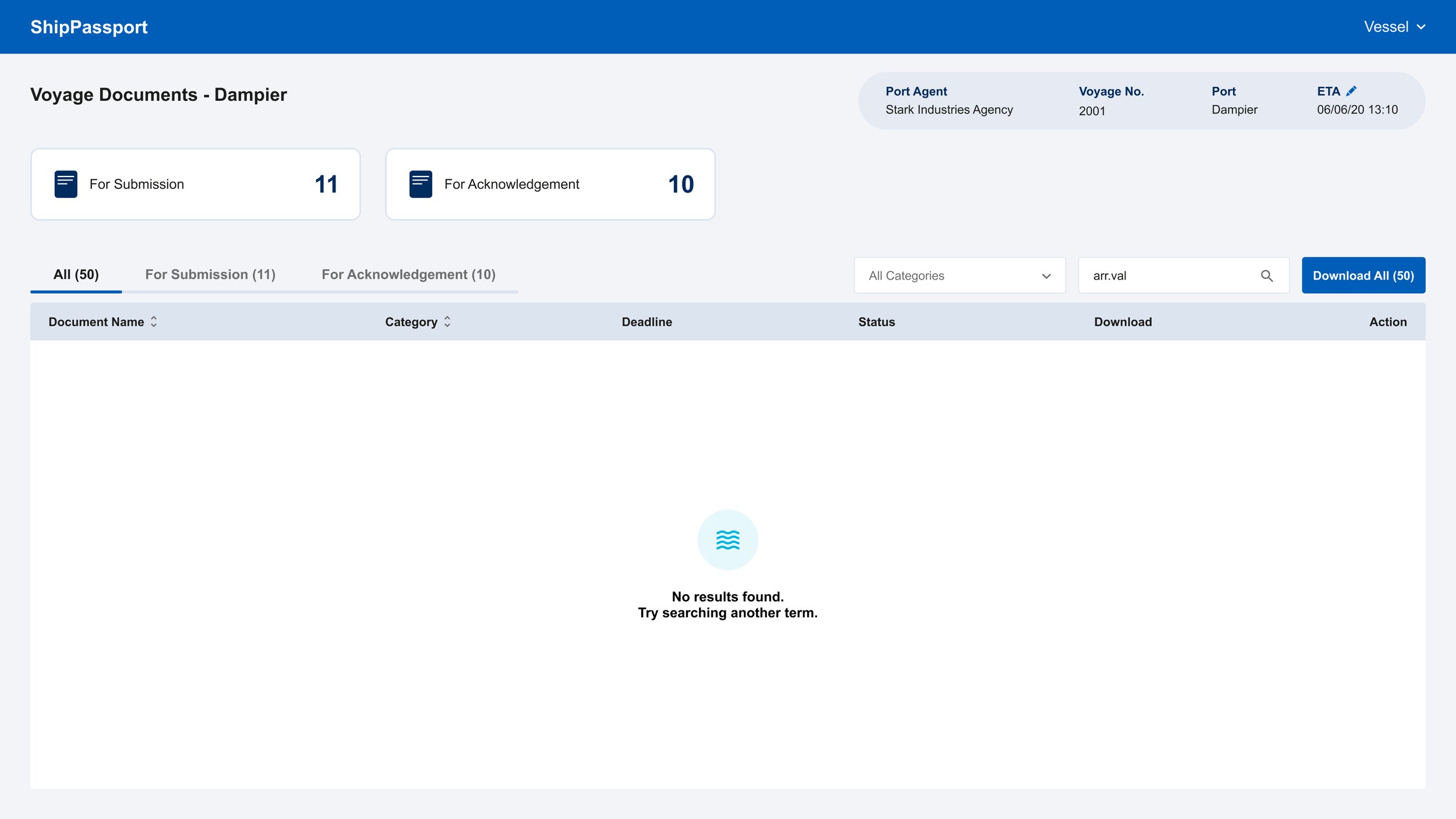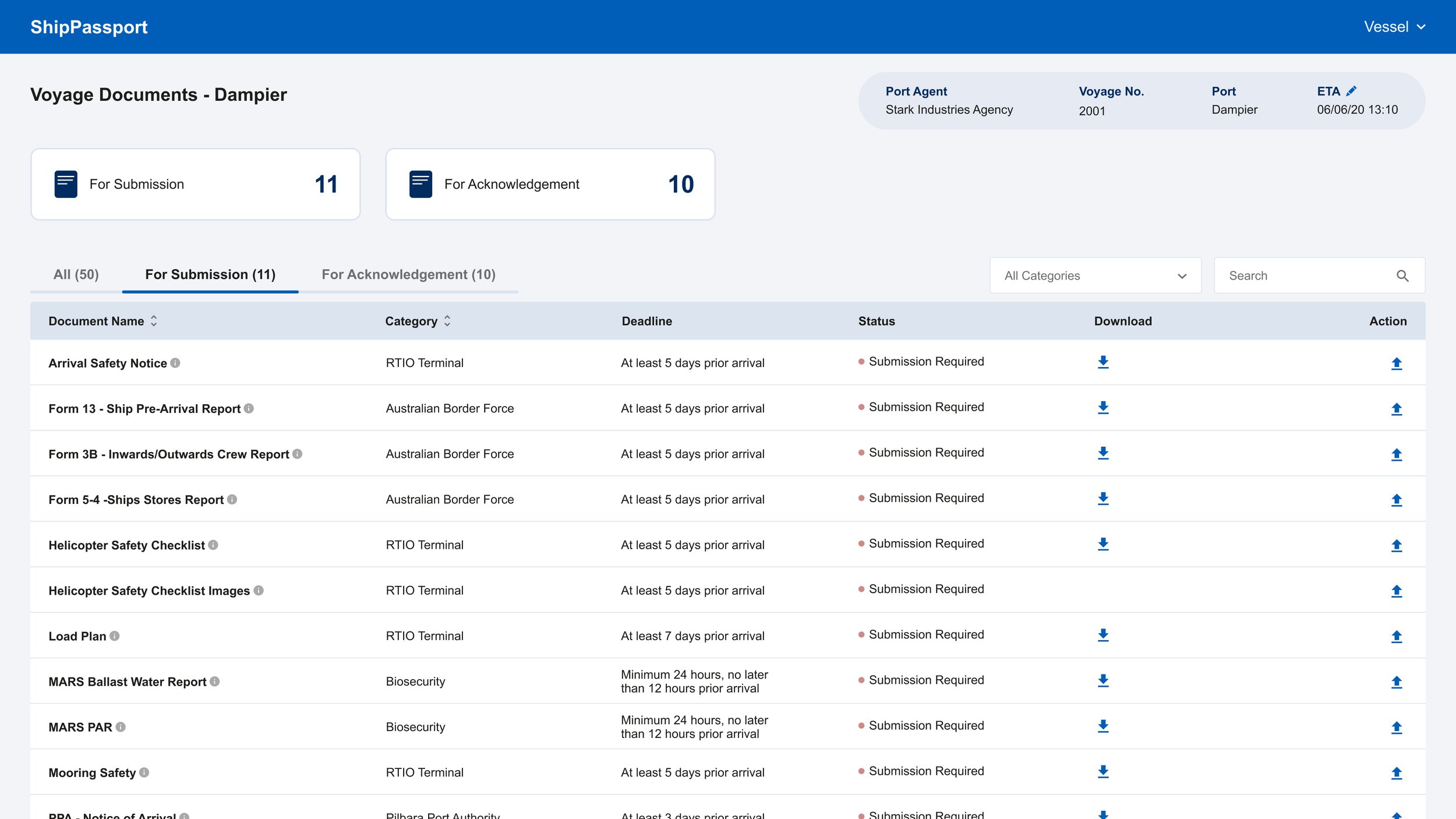Rio Tinto-ShipPassport
ShipPassport is a digital portal designed to efficiently manage the necessary arrival documentation for port visits. This innovative platform serves as a crucial tool for vessel captains, enabling them to effortlessly submit pre-arrival documentation. Furthermore, ShipPassport is equally indispensable for the dedicated port agents appointed by Rio Tinto. These agents rely on the platform to oversee and ensure the secure and efficient arrival of vessels at our ports, contributing to the smooth functioning of maritime operations.
Features
Manage arrival documentation related to port visit
a library of static documents custom to the voyage
workflow related to providing the documentation
When I was initially approached to provide guidance on this project, the system was already in active use at sea. It was imperative to proceed with caution and refrain from making drastic alterations. Therefore, Jakob’s Law principles were carefully applied to ensure minimal disruption, particularly in terms of the table taxonomy, which was modified using standard traffic light indicators for document status. This approach allowed users to navigate the site in a manner consistent with their familiarity from other platforms. Additionally, the Law of Common Region was implemented for the uploading and viewing of documents, acknowledging that users tend to carry out these tasks in distinct stages, perceiving these elements as grouped due to their shared space with well-defined boundaries.
Research
This research initiative was extended to encompass a comprehensive understanding of the customers' needs, incorporating Diary Review and extensive User interviews at all touchpoints of the platform. As part of this extension, a meticulous set of users' feedback was transcribed and outlined using the MoSCoW method, a prioritization technique for managing requirements. Additionally, UI edits were made to the tables' action buttons, with functions crafted to visually depict the changing status of each stage of the vetting process. This expansion brought about a more in-depth exploration of user needs and preferences, leading to a more thorough understanding of the ideal customer experience. The incorporation of these additional methods and techniques enhanced the overall depth and quality of the research initiative.
Refining the Code &
Design System
Along with the myriad of required and unnecessary documents necessary before a vessel could dock, time and internet access presented major obstacles. Securing both a stable internet connection and adequate time proved to be tasks in themselves. Conversations with the ship's staff revealed that certain documents would require significant processing time, while others would need editing or transfer to different platforms and then uploaded to ShipPassport. While the processing time for documents was largely contingent on third-party and government processes, addressing issues related to data connection on the platform was within our control.
At sea, the only dependable data connection is through satellites, which are often unreliable. Additionally, when at port, access to WiFi may be uncertain, not to mention the exorbitant costs associated with its usage, particularly the expensive MB charges. The most viable solution to mitigate the tax on data usage involved redefining the design system to feature plain, simple colors such as whites and blues, enabling faster transfer and reducing heavy load times on the page. This entailed refining image file sizes or removing them as necessary, as well as streamlining CSS and script file loads. Unclean CSS and script files can significantly impact page load times, making their refinement crucial. Moreover, presetting caching correctly upon user logins with onboarding pop-ups allows the browser to store these resources or files for subsequent requests, further optimizing the system's performance.
Uploading & View
Documents
When designing the Uploading Document flow, the primary consideration was to ensure it was minimal, memorable, and streamlined for user convenience. The upload process was designed to utilize the standard OS browse model to minimize processing time and leverage user familiarity. Subsequent updates in the "For Submissions" tab of the Dashboard table would prominently display new document additions, indicated by color-coded rows added to the top of the table.
For viewing documents, a user-friendly pop-up window interface was implemented, with all functional buttons conveniently located at the top. This allowed users to easily review the number of documents uploaded, with an option to download as needed. Incorporating user feedback, the system's ability to preview uploaded documents was deemed beneficial, particularly for cases where multiple sets of the same document with different input text were required. The preview feature provided users with added confidence in ensuring the accuracy of their submissions.

























